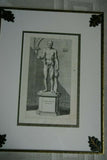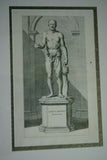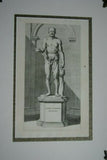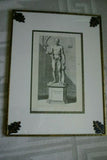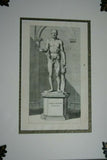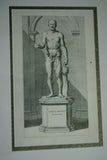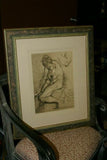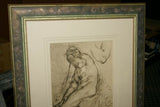Very rare Original folio copperplate engraving dating 1660 Seneca Moriens In Balneo Rome Nude from Villa Pamphilia: eiusque Palatium Printed on hand-made watermarked laid paper 360+ years old!!! Double matted & Framed in hand painted signed frame
Original plate from 1660 from Villa Pamphilia: eiusque Palatium
Printed on hand-made, watermarked laid paper
360+ years old!!!
ITEM DFPO40A
Authentic and extremely rare
PERFECT ANTIQUE
AUTHENTIC
PROFESSIONALLY FRAMED IN A HAND-PAINTED FRAME AND DOUBLE-MATTED
We recently closed our gallery of rare antique books and prints, original signed art and unique hand painted frames, some of the prints and art framed, some not, and all our artwork and antique prints will be listed here daily as we go.
EXTREMELY RARE!
ON SPECIAL
Nicely framed antique
Very rare
Original 17th C. Folio Copper Plate Engraving
(seen on 10 of the photos)
Framed in a delicately hand-painted frame by artist created to enhance the lithograph, and double matted professionally with 2 acid-free mats, one of them hand painted with intricate details by the same artist.
Finished size is: 24 1/2" x 18 1/4"
GREAT CONDITION, INSPECT CAREFULLY TO BE SATISFIED
Nude man’s statue called Seneca Moriens In Balneo. Published in Rome C. 1660.
printed on hand made watermarked laid paper.
From a splendid collection of the various fountains (many nudes) and landmarks of Rome.
It has become extremely hard to find folio size portrait engravings of this quality and condition.
Size: 11 5/8” x16 5/8” (plate marks at 7 ¼”x 13 5/8”)
Finished size with frame: 24 ½” x18 ¼”
Good condition, one small foxing area just off the right plate mark
This is an original and rare engraving from work entitled:
Villa Pamphilia: eiusque Palatium, cum suis prospectibus, statuae, fontes, vivaria, theatra, areolae, plantarum, viarumque ordines, cum eiusdem villae absoluta delineatione.
Rome: Author, Giovanni Giacomo de Rossi, [ca 1650-1655].
Contributors: Giovanni Giacomo de Rossi (author) 1627-1691, Giovanni Battista Falda, 1643-1678, Barrière, Dominique, 1620-1678.
Barrière and his assistants created copper plates (some of which survived SUCH AS THIS ONE) in the 1650s. The present book was likely produced in the 1660s, after the death of Camillo Pamphili, at which point Falda’s images of fountains and gardens were added. The gardens also included “natural” areas with groves and a zoological collection. The above image, for example, shows elements of the Roman countryside (cows, a hunt, fishing, a boy with a flute, even a tent in the upper right) that have been incorporated into this urban garden.
Published: Romae : Formis Io. Iacobi de Rubeis, in Latin. Italian 17th century.
Subject: Villa Doria Pamphili (Rome, Italy)—Pictorial works, Sculpture, Classical—Italy—Rome—Pictorial works, Fountains—Italy—Rome—Pictorial works.
NOT A REPRODUCTION
Giovanni Giacomo de Rossi (1627 – 1691) was an Italian engraver and printer, active in Rome in the second half of the 17th century.
His father, Giuseppe de Rossi (1570-1639), was the founder of the most important and active printing press of the 17th century in Rome. The printing press begun in 1633, by Giuseppe de Rossi, and it passed firstly to Giovanni Giacomo and to his brother Giandomenico (1619-1653), and then later to Lorenzo Filippo (1682-?); in 1738 it became the Calcografia Camerale, from 1870 until 1945 the Regia Calcografica, and today it is known as the Calcografia Nazionale. Here are conserved, amongst many others, the plates of Giambattista Piranesi (1720-1778).
Giovanni Giacomo de Rossi was the most involved of all the various family members who ran the press, and he worked between 1638 and 1691, and was to take the company to the height of its success. The artists that he printed the etchings for included Giovanni Benedetto Castiglione (1609-1665), Pietro Testa (1612-1650) and Giovan Francesco Grimaldi (1606–1680).
Giovanni Battista Falda (Valduggia 7 December 1643 – 22 August 1678 Rome) was an Italian architect, engraver and artist. He is known for his engravings of both contemporary and antique structures of Rome.
Falda was sent as a boy to Rome, to work in the studio of Bernini, and his draughtsmanship caught the eye of the publisher Giovanni Giacomo de Rossi. He engraved for Le fontane di Roma (Fountains in Rome) and for Palazzi di Roma (Palaces of Rome). The former books was expanded after Falda's death with engravings by Francesco Venturini. The latter was published in 1655 in collaboration with Pietro Ferrerio. He is sometimes known as 'Falda da Valduggia' because of his birthplace.
His works became particularly popular with the first waves of Grand Tour participants during the latter parts of the 17th century and Falda became a commercial success as a result. His works appealed to tourists keen to retain a detailed and accurate representation of those parts of Rome they had visited.
Barrière was born at Marseilles in about 1622. He spent most of his career in Rome, where he engraved a considerable number of plates, after Claude and other landscape painters, as well as other subjects. They are neatly etched in the manner of Stefano della Bella. He died in Rome in 1678. He sometimes signed his plates with his name, Dominicus Barriere Massiliensis, and sometimes with the cipher which is the mark used by Domenico del Barbiere, and thus mistakes frequently arise, although their styles are extremely different.
His works include:
· Portrait of Jean de la Valette; marked D. B.; scarce
· A set of 12 landscapes, dedicated to Lelio Orsini, 1651
· Seven Views of the Villa Aldobrandini, 1649
· Eighty-four views and statues of the Villa Pamphili.
· Sepulchral Monument of N. L. Plumbini, Dominicus Barriere Gallus, in. ex. del. et scul.
· Hercules, after a basso-rilievo in the Medicean Garden
· A large plate; entitled Circum Urbis Agonalibus, etc. with many figures, 1650
· Several plates of the History of Apollo, after the pictures by Domenichino and Viola
·
About the volume itself: [BARRIÈRE, Dominique (c.1622-1678) and Giovanni Battista FALDA (c. 1640-1678).]Villa Pamphilia eiusque palatium, cum suis prospectibus, statue, fontes, vivaria, theatre, areolae, plantarum, viarumque ordines, cum eiusdem villae absoluta delineatione. Rome: G.G. de' Rossi [c.1675-1677]. EXTREMELY RARE WORK: Villa Pamphili was the last and most magnificent of the Roman villas built in the 16th- and 17th- centuries: the construction of the villa, under the architect G.F. Grimaldi and the sculptor Algardi,lasted from 1644 to 1648, and the gardens were laid out in 1650. The house included some of the finest stucco work of the 17th century, and a main feature of the gardens was the collection of Roman and Greek statuary, displayed in niches in the facade of the villa and in the grounds. Shortly after this collection was installed, Pamphili commissioned Barrière -- one of the pre-eminent architectural draughtsmen in Rome in the 1640 and 1650s -- to draw and engrave views of the Villa and a number of the statues; this commission was probably executed by Barrière (together with Carlo Orlandi, thought to be an assistant or student) between 1652 and 1657, when payments to them are recorded. After Camillo Pamphili's death in 1666, the plates were inherited by his son Giambattista, who presumably arranged the publication of Villa Pamphilia by de' Rossi. Further plates were engraved for the work, and 4 plates from G.B. Falda's Le fontane di Roma were also included.
The Pamphili were a Roman dynasty. Giovanni Battista Pamphili (1574-1655) became Pope Innocent X in 1644. His nephew, Camillo Pamphili (1622-1666), was a Cardinal. The Villa Pamphili was a magnificent Roman villa built over the 16th and 17th centuries.
The book includes 76 illustrations of statuary by Barrière and illustrations of the villa and fountains by Giovanni Battista Falda, a printmaker known for his illustrations of fountains and gardens. A doorway featuring a vignette of the Pamphili family arms above left and a Statue of Cybele above right.
The villa’s gardens featured a collection of sculpture displayed in architectural niches and throughout the grounds. Dominicus Barrière (d. 1678)—one of the preeminent architectural draftsmen in Rome—was commissioned to draw and engrave views of the Villa Pamphili and a number of its statues.
This is reduced since we just closed our art gallery and are liquidating what is left.
The print is a very rare original!
This is a real bargain, and ready to go!
It makes a great gift for collectors of rare prints.
We also carry loose original prints 300 years old or less in great condition such as: Albin, Audubon, Baron, Barraband, Bertuch, Brodtmann, Brown, Buffon, Cassel, Curtis, Cuvier, Donovan, Edwards, Fitch, Frisch, Grandville, Harrison, Walter Hood, Latham, Linden,Linnaeus, Loddiges, Martinet, McKenney, Morris, Munting, Redoute, Reinchenbachia, Schreber, Schubert, Selby, Shaw and Nodder, Van Geel, Warner, etc.... etc...
Again, we closed our art store of antique prints and custom frames as well as our store of rare artifacts from around the world and we will now sell them direct to the public here. We have 1000's of antique prints and it will take a while to do so, so if you are interested in prints from the names above or others since I did not have time to list them all, please contact us.












